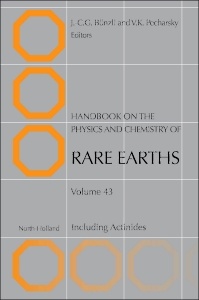Description
Handbook on the Physics and Chemistry of Rare Earths
Including Actinides
Handbook on the Physics and Chemistry of Rare Earths Series
Coordinators: Bünzli J.-C. G., Pecharsky Vitalij K.
Language: English
Subjects for Handbook on the Physics and Chemistry of Rare Earths:
638 p. · 15x22.8 cm · Hardback
Out of Print
Description
/li>Contents
/li>Readership
/li>Biography
/li>Comment
/li>
The rare earths represent a group of chemical elements, the lanthanides, together with scandium and yttrium, which exhibit similar chemical properties. They are strategically important to developed and developing nations as they have a wide variety of applications in catalysis, the defense industry, aerospace, the materials and life sciences and in sustainable energy technologies.
The Handbook on the Physics and Chemistry of the Rare Earths is a continuing authoritative series that deals with the science and technology of the rare earth elements in an integrated manner. Each chapter is a comprehensive, up-to-date, critical review of a particular segment of the field. The work offers the researcher and graduate student a complete and thorough coverage of this fascinating field.
Ionic liquids: new hopes for efficient lanthanide/actinide extraction and separation? Isabelle Billard
Recycling of rare earths from scrap, M. Tanaka, T. Oki, K. Koyama, H. Narita, T. Oishi
Structural properties of lanthanides at ultra high pressure, Gopi K. Samudrala andYogesh K. Vohra
Thermodynamic properties of scandium, yttrium and the lanthanide metals, John William Arblaster
While in Lviv, V. Pecharsky was studying phase relationships and crystallography of ternary intermetallic compounds containing rare earths. After moving to Ames his research interests shifted to examining composition-structure-physical property relationship of rare-earth intermetallic compounds. Together with Karl Gschneidner, Jr., he discovered a new class of materials that exhibit the giant magnetocaloric effect in 1997, triggering worldwide interest in caloric materials and caloric cooling, which promises to become an energy-efficient, environmentally-friendly alternative to conventional vapor-compression approach. Today his research interest include synthesis, structure, experimental thermodynamics, physical and chemical properties of intermetallic compounds containing rare-earth metals; anomalous behavior of 4f-electron systems; magnetostructural phase transformations; physical properties of ultra-pure rare earth metals; caloric materials and systems; hydrogen storage materials; mechanochemistry, mechanically induced solid-state reactions and mechanochemical transformations.
He organized the 28th Rare Earth Research Conference in Ames, Iowa in 2017. He serves as co-editor of the H
- Individual chapters are comprehensive, broad, critical reviews
- Contributions are written by highly experienced, invited experts
- Gives an up-to-date overview of developments in the field




